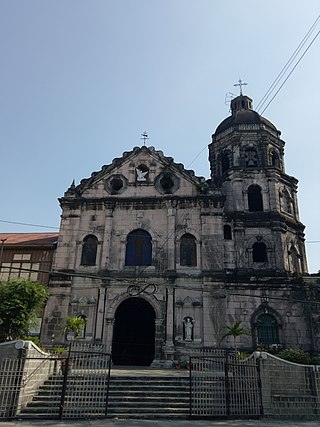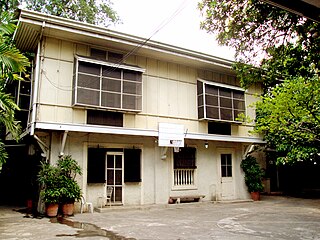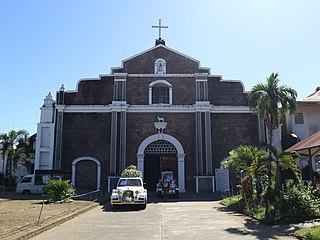
Quiapo is a district of the city of Manila, in the National Capital Region of the Philippines. Known as the “Old Downtown of Manila", the district’s most famous landmark is Quiapo Church, a minor basilica enshrining Asia's most sacred Black Nazarene image, which has been processed every January in the historic district, attracting millions of devotees from all over the country and region. The historic district is also dotted with numerous heritage sites, ranging from ancestral and heritage houses such as those in Hidalgo Street, museums, art galleries, libraries, historic places of worship such as churches and mosques, historic cinemas, as well as historic parks and streets, many of which have been run over by informal settlers and the construction of shanty houses, as well as buildings built by corporations. Many historic sites were destroyed by both the Japanese and American colonizers during World War II without compensation or aid for reconstruction, while some post-war sites were demolished by certain corporations. In recent years, various heritage organizations, experts, and lawmakers have pushed for the re-vitalization of Quiapo as a heritage zone, including the rebuilding of lost heritage structures, the revamping of modern structures to fit the historic district's original aesthetics, as well as the planting of trees and plants and the refurnishing of streets to make the district more safe, walkable, and climate-adaptive.

The Rizal Memorial Coliseum is an indoor arena in the Rizal Memorial Sports Complex in Manila, Philippines. It can hold up to 6,100 people.

The National Museum of the Philippines is an umbrella government organization that oversees a number of national museums in the Philippines including ethnographic, anthropological, archaeological, and visual arts collections. From 1973 until 2021, the National Museum served as the regulatory and enforcement agency of the government of the Philippines in the restoring and safeguarding of significant cultural properties, sites, and reservations throughout the Philippines. The mandate has since been transferred to the National Commission for Culture and the Arts.

The Manila Army and Navy Club founded in 1898 was the first American social club to be established in the Philippines for the exclusive use of the U.S. military personnel and civilians, and later Filipinos. Since the time it was established, it was one of the centers of Manila's social life. It was the site of many important events in Philippine–American relations.
The national symbols of the Philippines consist of symbols that represent Philippine traditions and ideals and convey the principles of sovereignty and national solidarity of the Filipino people. Some of these symbols namely the national flag, the Great Seal, the coat of arms and the national motto are stated in the Flag and Heraldic Code of the Philippines, which is also known as Republic Act 8491. In the Constitution of the Philippines, the Filipino language is stated as the national language of the Philippines. Aside from those stated symbols in the Constitution and in Republic Act 8491, there are only six official national symbols of the Philippines enacted through law, namely sampaguita as national flower, narra as national tree, the Philippine eagle as national bird, Philippine pearl as national gem, arnis as national martial art and sport and the Filipino Sign Language as the national sign language. Thus, there is a total of twelve official national symbols passed through Philippine laws.

The Philippine Registry of Cultural Property, abbreviated as PRECUP, is a national registry of the Philippine Government used to consolidate in one record all cultural property that are deemed important to the cultural heritage, tangible and intangible, of the Philippines. On June 11, 2018, the entries in the newly updated PRECUP was at 3,921. Additionally, 1,259 out of 1,715 LGUs, or 73 percent of LGUs have established local cultural inventories (LCI).

The Cagsawa Ruins are the remnants of a 16th-century Franciscan church, the Cagsawa church. It was originally built in the town of Cagsawa in 1587 but was burned down and destroyed by Dutch pirates in 1636. It was rebuilt in 1724 by Fr. Francisco Blanco but was destroyed again, along with the town of Cagsawa, on February 1, 1814, during the eruption of Mayon Volcano.

Saint Augustine Parish Church, commonly known as Paoay Church, is a Roman Catholic church in the municipality of Paoay, Ilocos Norte in the Philippines. It is under the jurisdiction of the Diocese of Laoag. Completed in 1710, the church is famous for its distinctive architecture, a highlight of which is the enormous buttresses on the sides and back of the building. It is declared as a National Cultural Treasure by the Philippine government in 1973 and a UNESCO World Heritage Site under the collective group of Baroque Churches of the Philippines in 1993.

Ancestral houses of the Philippines or Heritage Houses are homes owned and preserved by the same family for several generations as part of the Filipino family culture. It corresponds to long tradition by Filipino people of giving reverence for ancestors and elders. Houses could be a simple house to a mansion. The most common ones are the "Bahay na Bato". Some houses of prominent families had become points of interest or museums in their community because of its cultural, architectural or historical significance. These houses that are deemed of significant importance to the Filipino culture are declared Heritage House by the National Historical Commission of the Philippines (NHCP), previously known as the National Historical Institute (NHI) of the Philippines. Preservation is of utmost importance as some ancestral houses have come into danger due to business people who buy old houses in the provinces, dismantle them then sell the parts as ancestral building materials for homeowners wishing to have the ancestral ambiance on their houses. These ancestral houses provide the current generation a look back of the country's colonial past through these old houses.
The National Cultural Heritage Act, officially designated as Republic Act No. 10066, is a Philippine law that created the Philippine Registry of Cultural Property (PRECUP) and took other steps to preserve historic buildings that are over 50 years old. It was signed into law on March 25, 2009.

The National Historical Commission of the Philippines (NHCP) and its predecessor agencies install historical markers in the Philippines and overseas to signify important and historic events, persons, sites, structures, and institutions. The commemorative plaques are permanent signs installed by the NHCP in publicly visible locations on buildings, monuments, or in special locations. The NHCP also allows local municipalities and cities to install markers of figures and events of local significance, although these markers are barred from using the seal of the Republic of the Philippines.

The National Shrine of Our Lady of the Abandoned, also known as Santa Ana Church, is a Spanish colonial period Roman Catholic church located in the district of Santa Ana in Manila, Philippines. It is under the jurisdiction of the Archdiocese of Manila. The parish was established by the Franciscan missionaries in 1578 under the patronage of Saint Anne. The present stone church was constructed by Vicente Inglés from 1720 to 1725 and was dedicated to its present patron, the Our Lady of the Abandoned. The revered image of its patron was made in Valencia, Spain in 1713 and arrived in the Philippines in 1717.

The Lichauco Heritage House, formally known as the O'Brien-Lichauco Heritage House is one of the oldest surviving houses in Santa Ana, Manila, Philippines. Originally built in 1859, the house was purchased in the late 1940s by a prominent Filipino lawyer and dignitary, Marcial Lichauco from a European family who had fled the Japanese occupation in the Philippines. The house was declared as a heritage house by the National Historical Commission on July 10, 2010. The Lichauco Heritage house is located along Pedro Gil Street. It is the only declared Heritage House in Santa Ana, and one of the only two declared heritage houses in Metro Manila along with Mira-Nila House in Quezon City.

Saint Andrew the Apostle Parish, commonly known as Bacarra Church, is a Roman Catholic church located in the municipality of Bacarra, Ilocos Norte, Philippines under the jurisdiction of the Diocese of Laoag.
Santa Ana is the only district in Manila which was spared from destruction during World War II. Civilians fleeing other parts of Manila sought refuge in this district during the war. Thus, many ancestral houses are still standing up to the present time. Dubbed as the "Forbes Park of Manila", some houses were owned by prominent personalities and wealthy families. The following is a list of historic houses in Santa Ana.

Santa Monica Parish Church, commonly known as the Alburquerque Church, is a Roman Catholic church in the municipality of Alburquerque, Bohol, Philippines. It is under the jurisdiction of the Diocese of Tagbilaran. The church was declared as an Important Cultural Property by the National Museum of the Philippines in 2013.

The Archdiocesan Shrine of Patrocinio de Maria Santisima, commonly known as Boljoon Church, is a Roman Catholic church dedicated to Our Lady of the Patronage in the municipality of Boljoon, Cebu, Philippines, under the Archdiocese of Cebu.

The Pila Historic Town Center is a historic district located at Barangay Santa Clara Norte, Pila, Laguna, Philippines. The district preserves examples of Spanish and American-era architecture found in its town proper laid out with the Spanish colonial town planning system for the Indies and is also a pre-Hispanic archaeological site. The National Historical Institute declared a specific portion of Pila as a National Historical Landmark in 2000. The town has been recognized by scholars as a possible contender in UNESCO as a world heritage site.

















